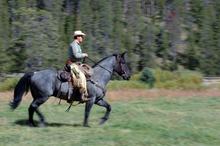Although September is World Rabies Awareness month rabies can happen any time. As more horses and riders hit trails and become involved in more outdoor activities during spring and summer months, knowledge about rabies is important in preventing attacks or bites by possible carriers of the disease.

Exposure to rabid animals on horse trails
Rabies is a viral disease that occurs mostly in carnivores and bats, but it can affect any mammal, including humans and horses and causes encephalitis (inflammation of the brain) and a variety of clinical signs.
According to research, the peak seasons for rabies exposure occur in late winter and again in late summer, but wild animals can contract the disease during any season of the year and have been known to attack horses and other domestic animals.
Rabies is a viral disease that occurs mostly in carnivores and bats, but it can affect any mammal, including humans and horses. It causes encephalitis (inflammation of the brain) and a variety of clinical signs.
The most common finding is a sudden change in the horse’s behavior. Aggressiveness or an apparent lack of fear is common with the “mad” or “furious” form, but some animals show minimal changes in behavior and become paralyzed with the “dumb” or “paralytic” form.
The onset of paralysis is often associated with salivation and the inability to swallow. The main concern caused by rabies is the fact that once clinical signs begin to appear, rabies is considered to always be fatal.
In the United States, less than 10,000 animal cases of rabies occur each year with fewer than 1,000 cases in domestic animals. Most of the cases in wildlife occur in raccoons, skunks, foxes, and coyotes; however, bats have become one of the most important reservoirs for rabies.
The incidence of rabies in domestic animals follows that of wildlife, which seems to follow a cycle of approximately eight to 10 years. Although rabies in horses is low approximately 5 percent, the potential for human exposure makes it important to discuss its causes, diagnosis, treatment and control.
Hawaii is the only state that does not have rabies.Since 1990, there have been 50 human deaths due to rabies in the U.S. Two-thirds of these have been associated with exposure to bats; the next most frequent type of exposure was due to contact with rabid animals while traveling in foreign countries. It usually takes from 20 to 60 days after exposure to rabies before clinical signs develop in humans.
Rabies is usually spread by the bite of infected animals because their saliva contains the infective virus as the disease develops. Rabies is transmitted much less frequently by contamination of existing cuts or wounds with saliva or by contact of saliva with mucous membranes, such as the lining of the eyes.
Rabies cannot be transmitted by contact with blood, urine, or feces from an infected animal. In most cases of rabies, infected animals begin shedding virus in their saliva at the same time that clinical signs begin to develop.
Learn more about Rabies in Horses
